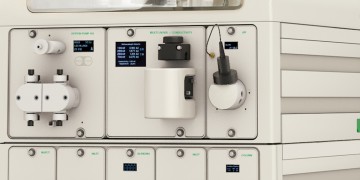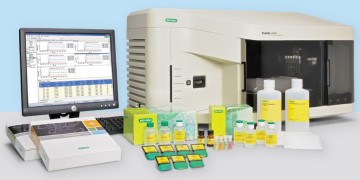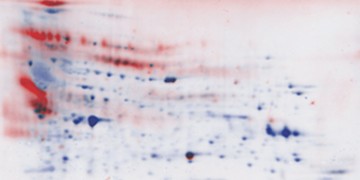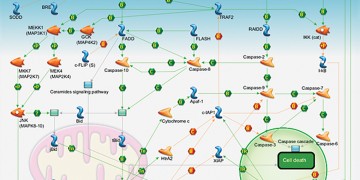
Better, Faster, and Less Expensive Gene Expression Analysis Using Multiplex One-Step RT-qPCR: A Case Study of Colorectal Cancer
Conducting a triplex one-step RT-qPCR assay promises a more efficient and economical analysis of gene expression compared to running three individual assays. This technical report describes a colorectal cancer case study where a triplex multiplex assay was validated.

Protein Purification Workflow Development Using Bio-Rad’s NGC™ Chromatography System
While using affinity tagging is the preferred method to achieve highly pure protein through recombinant expression, this approach isn’t feasible for all proteins. This tech report describes workflow optimizations using the NGC Chromatography System that allow users to achieve high purities with untagged proteins.

Novel Liposome-Capture Surface Chemistries to Analyze Drug-Lipid Interaction Using the ProteOn™ XPR36 System
Surface plasmon resonance (SPR) biosensors offer a label-free technique for profiling biomolecular interactions, including those between drugs and liposomes. Here we describe the novel surface chemistries that make capturing liposomes possible, and explore the application of the liposome capturing kit in analyzing liposome-small molecule interactions.

Applications of Bio-Plex Pro™ Cell Signaling Akt and MAPK Assay Panels in Signal Transduction Pathways
The Akt and MAPK signal transduction pathways are key areas of study for their roles in cell growth, function, and death, as well as for their possible roles in cancer development and diabetes. Bio-Rad’s new Bio-Plex Pro™ Akt and MAPK cell signaling assays enable researchers to study the activation of these key pathways as a response to various stimuli. This technical report validates the sensitivity and specificity of these assays after cells were exposed to insulin, EGF (epidermal growth factor), and UV radiation.

Efficient SPR-Based Fragment Screening and Small Molecule Affinity Analysis Using Bio-Rad’s ProteOn™ XPR36 System
Fragment-based screening has emerged as an important tool for identifying lead compounds in drug discovery, though the molecules involved present challenges related to their low affinity. Label-free surface plasmon resonance (SPR) analysis provides an efficient and reproducible solution to these challenges. Here we describe ways to determine small molecule affinity that combines high sensitivity and high throughput with low sample consumption.

Reliable, Streamlined 2-D Western Blot Workflow for Evaluation of Antibodies Developed for Detection of Host Cell Proteins
Removing host cell protein (HCP) contaminants represents an essential step in the production of biologics (therapeutic protein drugs), but has long been a time- and labor-intensive process. Here, we demonstrate a simpler, quicker, and more standardized workflow for evaluating anti-HCP antibodies using 2-D electrophoresis and western blotting.

Immobilization of Active Kinases for Small Molecule Inhibition Studies
Surface plasmon resonance (SPR) is a well-established and important screening tool in the small molecule drug discovery workflow. Using the Bio-Rad SPR system ProteOn XPR36, rapid optimization of immobilization conditions for a kinase target was carried out in a fast workflow with a single sensor chip, showing the high performance of the ProteOn XPR36 system.

PrimePCR™ Pathway Analysis: Pathway Curation and Real-Time PCR Panel Design Strategy
Pathway analysis is an efficient approach for studying a large number of related gene targets in a single experiment. Bio-Rad Laboratories and Thomson Reuters, a leading provider of system biology tools, have partnered to provide predesigned pathway panels for gene expression analyses using real-time qPCR. This tech report describes how Bio-Rad’s PrimePCR™ pathway panels were curated and designed using a ranking strategy developed by Thomson Reuters.

PrimePCR™ Assays: Meeting the MIQE Guidelines by Full Wet-Lab Validation
The MIQE guidelines have set a new standard for publishing qPCR results to ensure integrity in the scientific literature and increase experimental transparency. One of the key guidelines focuses on the proper design and experimental validation of primer assays used in qPCR. This tech report describes the design and wet-lab validation of PrimePCR assays and how they comply with the MIQE guidelines.

Multiplex Analysis of Inflammatory Markers Using Bio-Plex Pro™ Human Th17 Cytokine Assays
The T-helper cell (Th17) pathway has been implicated in several autoimmune diseases and in cancer. New magnetic bead–based assays have been developed for several biomarkers in this pathway. The performance characteristics of these assays are evaluated from data on intra- and inter-assay precision, standard curve recovery, cross reactivity, and linearity of dilution.
